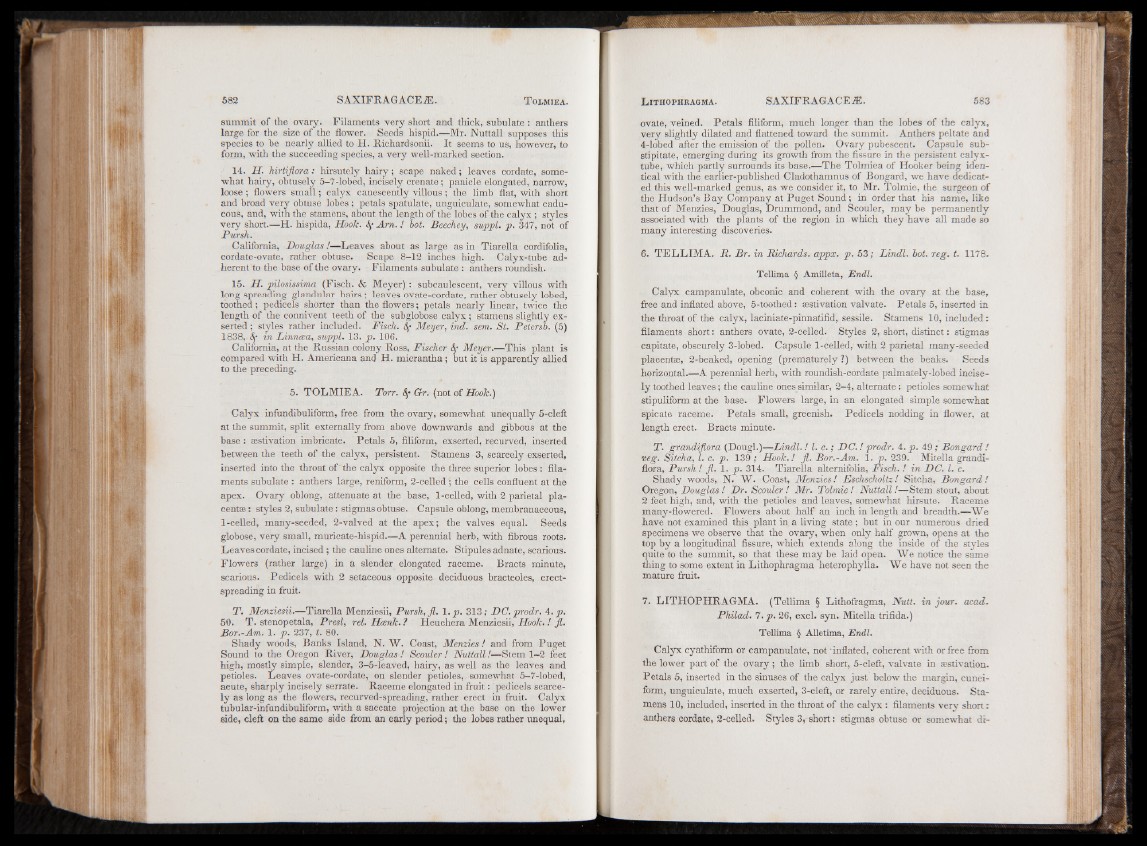
summit of the ovary. Filaments very short and thick, subulate : anthers
large for the size of the flower. Seeds hispid.—Mr. Nuttall supposes this
species to be nearly allied to H. Richardsonii. It seems to us, however, to
form, with the succeeding species, a very well-marked section.
14. H. hirtijlora: hirsutely hairy; scape naked; leaves cordate, somewhat
hairy, obtusely 5-7-lobed, incisely crenate; panicle elongated, narrow,
loose; flowers small; calyx canescently villous; the limb flat, with short
and broad very obtuse lobes ; petals spatulate, unguiculate, somewhat caducous,
and, with the stamens, about the length of the lobes of the calyx ; styles
very short.—H. hispida, Hook, dy Am. ! lot. Beechey, svppl. p. 347, not of
Pursh.
California, Douglas!—Leaves about as large as in Tiarella cordifolia,
cordate-ovate, rather obtuse. Scape 8-12 inches high. Calyx-tube adherent
to the base of the ovary. Filaments subulate : anthers roundish.
15. H. pilosissima (Fisch. & Meyer): subcaulescent, very villous with
long spreading glandular hairs ; leaves ovate-cordate, rather obtusely lobed,
toothed ; pedicels shorter than the flowers; petals nearly linear, twice the
length of the connivent teeth of the subglobose calyx ; stamens slightly ex-
serted; styles rather included. Fisch. 8f Meyer, ind. sem. St. Petersb. (5)
1838, in Linncea, suppl. 13. p. 106.
California, at the Russian colony Ross, Fischer Sf Meyer.—This plant is
compared with H. Americana and H. micrantha; but it is apparently allied
to the preceding.
5. TOLMIEA. Torr. Gr. (not of Hook.)
Calyx infundibuliform, free from the ovary, somewhat unequally 5-cleft
at the summit, split externally from above downwards and gibbous at the
base: aestivation imbricate. Petals 5, filiform, exserted, recurved, inserted
between the teeth of the calyx, persistent. Stamens 3, scarcely exserted,
inserted into the throat of the calyx opposite the three superior lobes : filaments
subulate : anthers large, reniform, 2-celled ; the cells confluent at the
apex. Ovary oblong, attenuate at the base, 1-celled, with 2 parietal placentae:
styles 2, subulate: stigmas obtuse. Capsule oblong, membranaceous,
1-celled, many-seeded, 2-valved at the apex; the valves equal. Seeds
globose, very small, muricate-hispid.—A perennial herb, with fibrous roots.
Leaves cordate, incised; the cauline ones alternate. Stipules adnate, scarious.
Flowers (rather large) in a slender elongated raceme. Bracts minute,
scarious. Pedicels with 2 setaceous opposite deciduous bracteoles, erect-
spreading in fruit.
T. Menziesii.—Tiarella Menziesii, Pursh, Jl. l .p . 313; DC. prodr. 4. p.
50. T. stenopetala, Presl, rel. Heenk. ? Heuchera Menziesii, Hook. ! Jl.
Bor.-Am. 1. p. 237, t. 80.
Shady woods, Banks Island, N. W. Coast, Menzies! and from Puget
Sound to the Oregon River, Douglas ! Scouler ! Nuttall!—Stem 1-2 feet
high, mostly simple, slender, 3-5-leaved, hairy, as well as the leaves and
petioles. Leaves ovate-cordate, on slender petioles, somewhat 5-7-lobed,
acute, sharply incisely serrate. Raceme elongated in fruit: pedicels scarcely
as long as the flowers, recurved-spreading, rather erect in fruit. Calyx
tubular-infundibuliform, with a saccate projection at the base on the lower
side, cleft on the same side from an early period; the lobes rather unequal,
ovate, veined. Petals filiform, much longer than the lobes of the calyx,
very slightly dilated and flattened toward the summit. Anthers peltate and
4-lobed after the emission of the pollen. Ovary pubescent. Capsule sub-
stipitate, emerging during its growth from the fissure in the persistent calyx-
tube, which partly surrounds its base.—The Tolmiea of Hooker being identical
with the earlier-published Cladothamnus of Bongard, we have dedicated
this well-marked genus, as we consider it, to Mr. Tolmie, the surgeon of
the Hudson’s Bay Company at Puget Sound; in order that his name, like
that of Menzies, Douglas, Drummond, and Scouler, may be permanently
associated with the plants of the region in which they have all made so
many interesting discoveries.
6. TELLIMA. R. Br. in Richards, appx. p. 5 3 ; Lindl. hot. reg. t. 1178.
Tellima § Amilleta, Endl.
Calyx campanulate, obconic and coherent with the ovary at the base,
free and inflated above, 5-toothed: aestivation valvate. Petals 5, inserted in
the throat of the calyx, laciniate-pinnatifid, sessile. Stamens 10, included:
filaments short: anthers ovate, 2-celled. Styles 2, short, distinct: stigmas
capitate, obscurely 3-lobed. Capsule 1-celled, with 2 parietal many-seeded
placentae, 2-beaked, opening (prematurely?) between the beaks. Seeds
horizontal.—A perennial herb, with roundish-cordate palmately-lobed incisely
toothed leaves; the cauline ones similar, 2-4, alternate: petioles somewhat
stipuliform at the base. Flowers large, in an elongated simple somewhat
spicate raceme. Petals small, greenish. Pedicels nodding in flower, at
length erect. Bracts minute.
T. grandijlora (Dough)—Lindl.! 1. c .; DC.! prodr. 4. p. 49; Bongard !
veg. Sitcha, l. c. p. 139 ; Hook.! jl. Bor.-Am. 1. p. 239. Mitella grandi-
flora, Pursh ! jl. 1. p. 314. Tiarella altemifolia, Fisch. ! in DC. 1. c.
Shady woods, N .' W. Coast, Menzies! Eschscholtz! Sitcha, Bongard !
Oregon, Douglas ! Dr. Scouler ! Mr. Tolmie ! Nuttall!—Stem stout, about
2 feet high, and, with the petioles and leaves, somewhat hirsute. Raceme
many-flowered. Flowers about half an inch in length and breadth.—We
have not examined this plant in a living state; but in our numerous dried
specimens we observe that the ovary, when only half grown, opens at the
top by a longitudinal fissure, which extends along the inside of the styles
quite to the summit, so that these may be laid open. We notice the same
thing to some extent in Lithophragma heterophylla. We have not seen the
mature fruit.
7. LITHOPHRAGMA. (Tellima § Lithofragma, Nutt, in jour. acad.
Philad. 7. p. 26, excl. syn. Mitella trifida.)
Tellima § Alletima, Endl.
Calyx cyathiform or campanulate, not inflated, coherent with or free from
the lower part of the ovary ; the limb short, 5-cleft, valvate in aestivation.
Petals 5, inserted in the sinuses of the calyx just below the margin, cuneiform,
unguiculate, much exserted, 3-cleft, or rarely entire, deciduous. Stamens
10, included, inserted in the throat of the calyx : filaments very short:
anthers cordate, 2-celled, Styles 3, short: stigmas obtuse or somewhat di